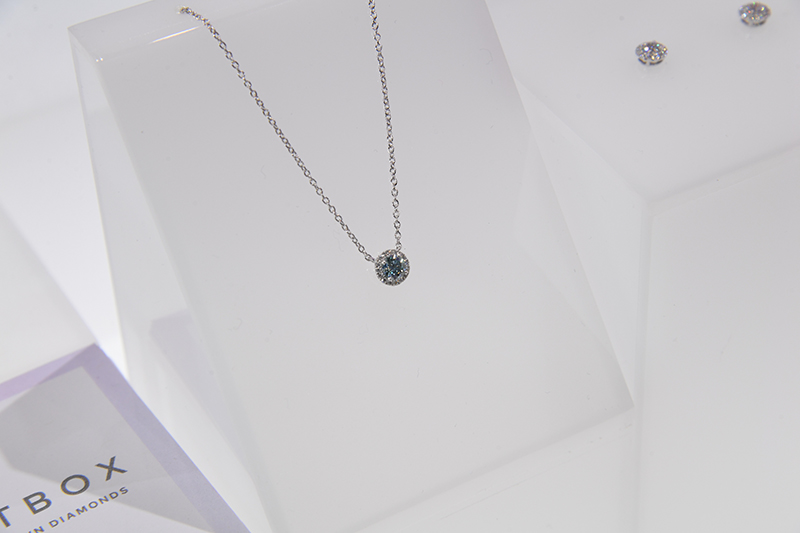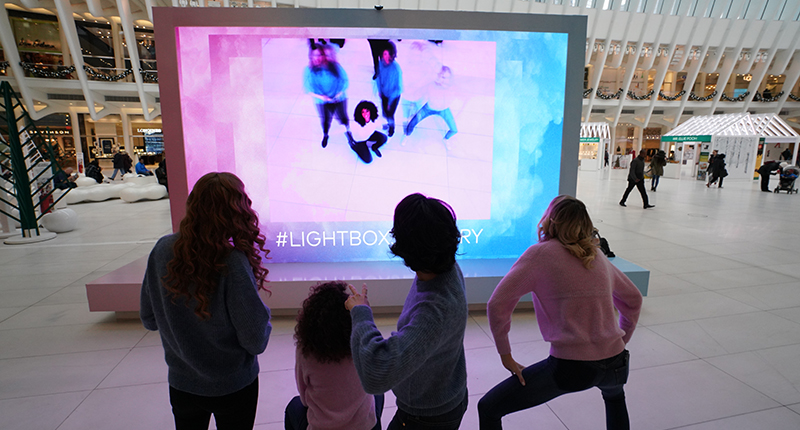The company is providing the opportunity for an FIT student to work alongside master diamond cutter Willie Lopez in its workshop.
Consumers Saw Lightbox. Here’s What They Wanted to Know
At a pop-up shop in New York, De Beers is giving the public the chance to see its lab-grown line in person for the first time.

New York—De Beers used to spread the message that “A Diamond Is Forever” around Grand Central Station at holiday time, appealing to the 750,000+ commuters crisscrossing the classic transit hub every day.
This year, the diamond miner and marketer is at it again, but now its promoting lab-grown diamonds at the Oculus, the two-year-old, ultra-modern transit hub at the site of the rebuilt World Trade Center.
Call it a sign of the times.
Back in September De Beers launched Lightbox, a line of moderately priced (the most expensive pieces on the site, 1-carat diamonds set in 10-karat gold, are $1,000) fashion jewelry set with man-made diamonds grown by its Element Six arm in the United Kingdom.
The line is fairly limited at this point—just blue, pink and white lab-grown diamonds set in either pendants or earrings, with blue and pink studs the runaway successes so far, said Lightbox Head of Marketing Sally Morrison.
It is sold online only, which means consumers haven’t had a chance to see, touch and feel it—until this week.
On Monday, Lightbox opened a pop-up shop at the Oculus, and this editor popped by Tuesday afternoon around 3:30, shortly before evening rush hour was in full effect, and lingered until a little after 5.
What became apparent in that time is this: Consumers are drawn in when they see something sparkly.
There was a constant stream of people in and out of the 20’ x 20’ structure the entire time.
But they don’t know as much about lab-grown diamonds as many in the trade might think, and there is confusion about how man-made diamonds differ from simulants.
“I’m intrigued. I’ve never heard of this before,” one woman wearing natural diamond stud earrings said as she entered the Lightbox space.
After the product and pricing was explained to her—it starts at $200 for a quarter carat and goes up to $800 for 1 carat, plus the cost of the setting—she seemed to like the idea, noting that lab-grown diamonds are “an accessible way to be able to give people a diamond.”
Multiple customers asked about the difference between lab-grown diamonds and CZ, and between the stones and another diamond simulant, moissanite, echoing the comments consumers made when National Jeweler conducted an informal poll on lab-grown diamonds four years ago.
There were also a lot of questions about how the quality of lab-grown diamonds compare
“There’s a lot of education to do, not just about our product but the category in general,” Morrison said Tuesday afternoon in an interview at the Lightbox booth. “There’s a lot of confusion.”

Morrison and her team—many of whom were clad in on-brand blue and pink sweaters—are learning that first-hand while manning the pop-up, which is set to remain open through Sunday.
Like the Blue Nile “webrooms,” the Lightbox pop-up is not selling the product it’s showing; customers cannot walk out with a little box of jewelry in their hands.
They can, however, order jewelry from an iPad set up in the left-front corner of the pop-up, or shop on the brand’s website after they leave.

De Beers announced just before the Las Vegas jewelry trade shows it would begin selling lab-grown diamonds, sparking a flurry of commentary in the industry.
Some applauded the move, claiming that the current crop of companies selling man-made diamonds are overcharging and De Beers’ pricing model would serve as a regulator.
Some existing sellers of lab-grown diamonds accused De Beers of predatory pricing, while retailers worried how Lightbox would impact sales of lower-end diamond fashion jewelry in their stores and bemoaned the addition of another supplier selling direct to the public.
RELATED CONTENT: Is De Beers’ Lab-Grown Line a Fit for Signet?The company has said it will make Lightbox available to brick-and-mortar jewelers in the future.
Morrison said Tuesday a brick-and-mortar test run is planned for 2019, though De Beers has not yet decided which retailers will carry the line.
In the meantime, the man-made diamonds continue to move online and Morrison is not ruling out the possibility of another pop-up.
She said that selling online and having this physical space is teaching them a lot about what consumers do, and don’t, like about the product.
“I think it’ll be better to go into brick-and-mortar (stores) when we know more about the customer and the response to the product,” she said.
The Latest

He is remembered for his successful entrepreneurship, generosity, and dedication to his family.

Welcome warm summer days with red hot rubies perfectly chosen as July’s birthstone.

The Seymour & Evelyn Holtzman Bench Scholarship from Jewelers of America returns for a second year.

Co-founders Afzal Imram and Lin Ruiyin brought their son’s story of a cosmic egg, toadstool, and railroad to life in their new collection.


The best time to prepare for the holiday season is right now, according to columnist Emmanuel Raheb.

This year’s winner is Morgan Keefe, who is currently studying at GIA to be a gemologist.

The countdown is on for the JCK Las Vegas Show and JA is pulling out all the stops.

“The Jewelry Book” comes out this September.

The company is focused on modernizing the custom jewelry buying experience with e-commerce tools like product visualization and 3D styling.

Following its recent acquisition, the storied brand has updated its leadership team and regional managers.

AGS also named the recipient of its “Women in Leadership” scholarship.

The 20-karat yellow gold and diamond wrap ring is modeled after the Monstera plants in the garden of the brand’s Miami villa.

Rocksbox President Allison Vigil shared the retailer’s expansion plans, and her thoughts on opening stores in malls.

The creator of the WJA Chicago chapter is remembered as a champion for women in the jewelry industry and a loving grandmother.

The decline was consistent across age groups and almost all income groups, with tariffs and inflation still top of mind.

The “Playlist: Electric Dreams” collection brings lyrics from the musician’s song, “Little Wing,” to life through fine jewelry.

The event is set for May 16-19 in Detroit, Michigan.

The Vault’s Katherine Jetter is accusing the retailer of using info she shared for a potential partnership to move into Nantucket.

Agents seized 2,193 pieces, a mix of counterfeit Cartier “Love” and “Juste Un Clou” bracelets, and Van Cleef & Arpels’ “Alhambra” design.

The designer brought her children’s book, “The Big Splash Circus,” to life through a collection of playful fine jewelry characters.

The trade association has chosen the recipients of the funding initiative it formed to foster the growth and sustainability of the industry.

The organization has also announced this year’s slate of judges.

Associate Editor Natalie Francisco shares 20 additional pieces that stood out to her at the Couture show.

Lori Tucker started at Williams Jewelers when she was 18 years old.

The “Marvel | Citizen Zenshin” watch is crafted in Super Titanium and has subtle nods to all four “Fantastic Four” superheroes on the dial.

The “XO Tacori” collection was designed to blend luxury and accessible pricing.

























